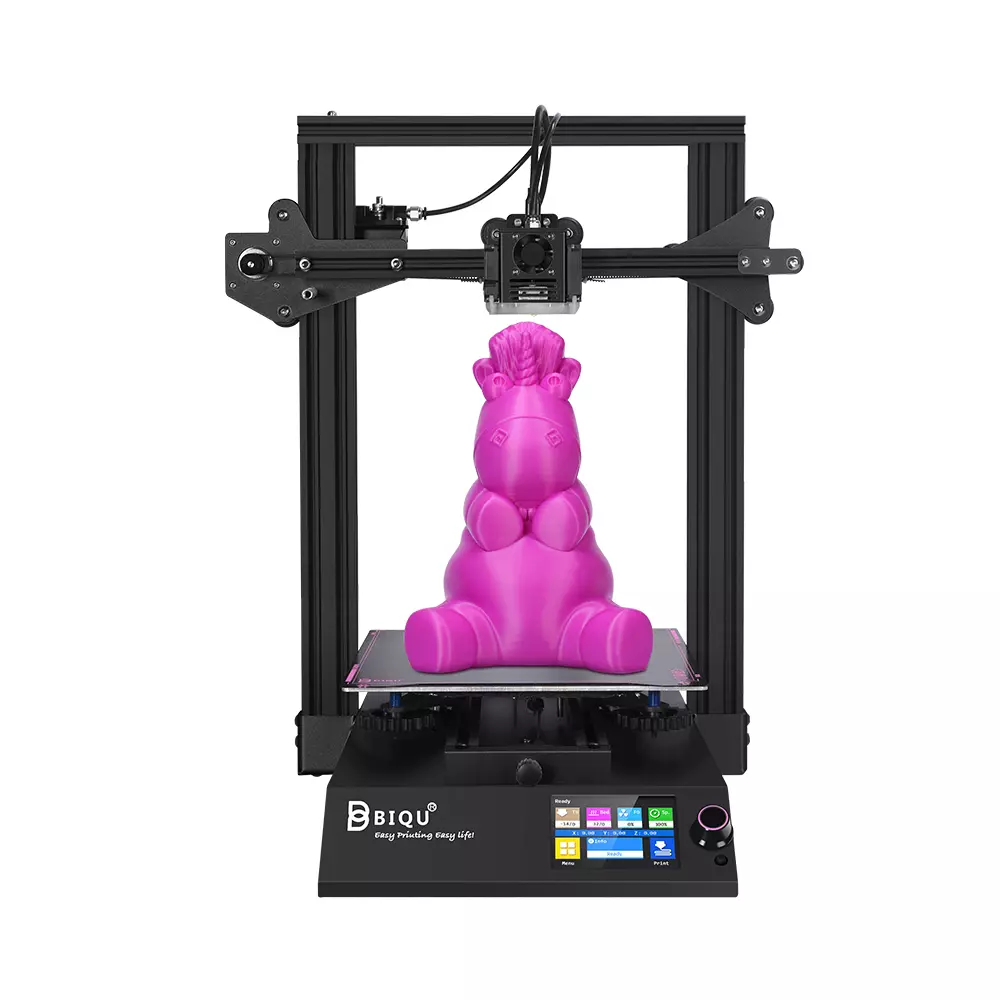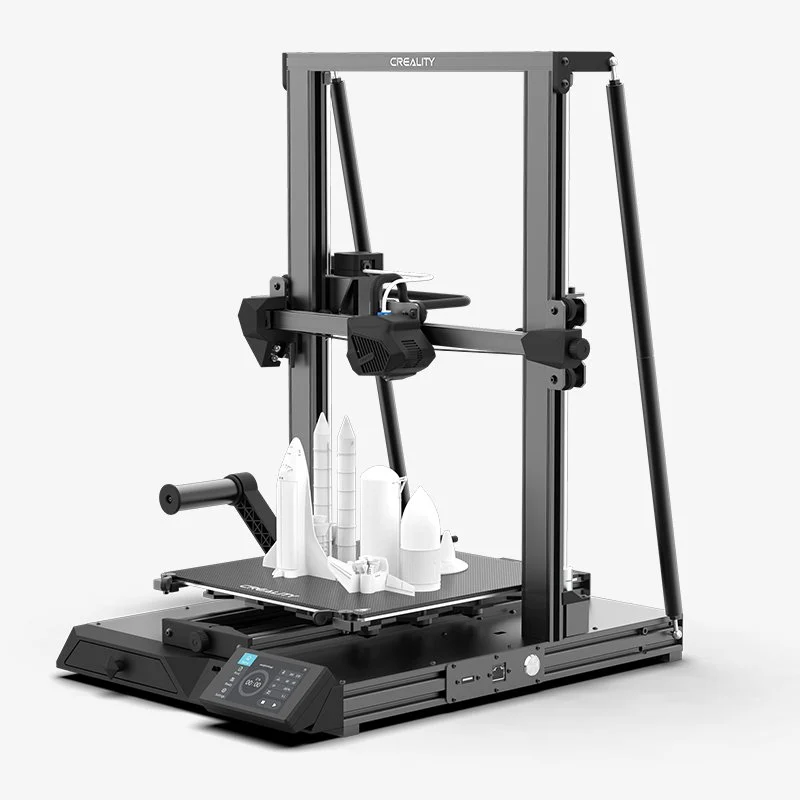Compare BIQU B1 vs CR 10 Smart
Comparison between the best 3D printers
Choose the best 3D printer at the best price. The cheapest 3D printers are here.
Buy a 3D printer here with 3D Fila.
 |
 |
|
| Model | BIQU B1 |
CR 10 Smart[BUY CR 10 Smart] |
| Printing Material | Filament | Filament |
| Buy Filament for BigTreeTech BIQU B1 | Buy Filament forCreality 3D CR 10 Smart | |
| Estimated price | $269,00 | $520,00 |
| Manufacturer | BigTreeTech | Creality 3D |
| Release Year | 2020 | 2021 |
| Print Volume [mm] | 235x235x270 | 300x300x400 |
| Printer Size [mm] | 412x402x492 | 578x522x648 |
| Weight [kg] | 8,00 | 14 |
| Power Loss Recovery | YES | YES |
| Enclosed printer | NO | NO |
| Bed Leveling | Manual | Automatic |
| Filament End Sensor | YES | YES |
| Bed type | Heated | Heated |
| Power supply system | Bowden | Bowden |
| Standard nozzle | 0,4 | 0,4 |
| Maximum Nozzle Temperature [°C] | 250 | 260 |
| Maximum Bed Temperature [°C] | 100 | 100 |
| Maximum printing speed [mm/s] | 100 | 200 |
| Filament holder | YES | YES |
| Camera for supervision | NO | NO |
| Recommended filaments | PLA, TPU, ABS, PETG | PLA, PETG, Tritan, Flex, ABS |
| Recommended slicers | Cura, Simplify, Slic3r | Cura, Simplify, Slic3r, IdeaMaker |
| Maximum Resolution [mm] | 0,1 | 0,1 |
| Processor | 32 Bits BTT SKR V 1.4 | Processador ARM STM32F103 RET6 CPU |
| Display | Touchscreen TFT 3,5'' | Display touchscreen 4,3'' |
| Power Supply | 24V / 360W | 110/220V / 350W |
| Connectivity | SD / USB | SD / USB / Wi-Fi |
| Operating systems | Windows, Mac, Linux | Windows, Mac, Linux |
| Date of registration in the system | 2021-04-14 | 2022-11-04 |
| Release date | 2020 | 2021 |
| Extra features | The BIQU B1 is an advanced 3D printer with a silent 32-bit BTT SKR V1.4 motherboard and ARM Cortex-M3 CPU, offering DIY interfaces (I2C, SPI, WiFi) and dual Z-axis. Its dual BTT B1 TFT35 V3.0 operating system allows real-time monitoring and multiple printing modes, including G-code visualization effects. It stands out for its BIQU SSS (Super Spring Steel), ensuring easy model adhesion and simplified removal, with the possibility of using it on both sides. It includes a filament sensor, automatically pausing printing in case of filament breakage. The multicolored RGB lights integrated into the hotend allow you to view the printing status even at night. Additional notes include the need for a BIQU-specific Type-C cable and extra interfaces for smart filament sensor and BL Touch. | The Creality CR-10 Smart stands out for its stability, with a dual Z axis and additional supports, minimizing oscillation in high prints. Its redesigned hotend offers better cooling, expanding the range of usable materials. The glass printing surface, with automatic leveling, facilitates the adhesion and removal of parts. Includes Wi-Fi / LAN connection and automatic shutdown after printing, adding convenience and efficiency. It features an effective single-gear extruder and an intuitive touchscreen interface, despite some firmware issues. |
| Support for multiple colors and materials (AMS and CFS) | NO | NO |
Notes * |
||
| Cost-benefit | 7 / 10 | 6 / 10 |
| Hardware | 2 / 10 | 2.4 / 10 |
| Tela | . | . |
| Print volume | 3 / 10 | 4 / 10 |
| Performance | 1 / 10 | 2 / 10 |
| [BUY CR 10 Smart] |
Conclusion |
| In comparing the BIQU B1 and the Creality CR-10 Smart, each printer has its strengths and weaknesses, making the choice largely dependent on the user's specific needs and budget. The BIQU B1 offers a more budget-friendly option while still incorporating several advanced features, such as a silent 32-bit motherboard and dual Z-axis system, which can benefit those who are looking for a reliable printer without breaking the bank. Its manual bed leveling may demand more hands-on involvement, but it compensates with features like the filament sensor and flexible build plate. The BIQU B1 is suitable for hobbyists or beginners familiar with 3D printing. On the other hand, the Creality CR-10 Smart comes at a higher price point but provides a larger print volume and automatic bed leveling, making it a great choice for users looking for ease-of-use and higher volume capabilities. It also features a more robust construction, ensuring stability during prints, alongside an intuitive touchscreen interface and additional connectivity options. These features may appeal to users interested in producing larger or more complex prints with less manual calibration. Ultimately, both printers score similarly in cost-benefit and overall performance while catering to different user preferences. The BIQU B1's affordability and unique features may attract budget-conscious hobbyists, whereas the CR-10 Smart's larger volume and automatic features are likely to appeal to users looking for convenience and capability in larger-scale projects. When choosing between the two, users should consider their specific requirements for print size, ease of use, and overall budget. |

